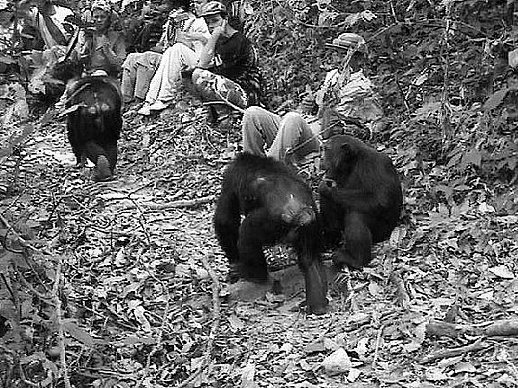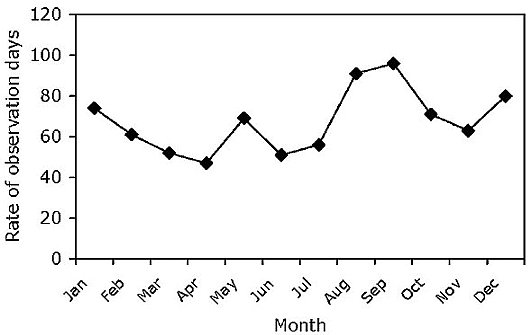|
<NOTE>
Introduction of Seasonal Park Fee System to Mahale Mountains National Park: A Proposal.
Toshisada Nishida1 and Crispin Mwinuka2
2.Tanzania Wildlife Research Institute: sokwe@mahale.org Since the Mahale Mountains National Park was established in 1985, the number of tourists visiting it has increased gradually (Figure 1). In 2002, the park welcomed over 400 visitors a year. Of course, this figure seems very small considering the capacity of the park, whose area exceeds 1,600 km2. 
Figure 1. Number of visitors to MMNP
However, even this apparently low usage rate is not really low from the viewpoint of the welfare of chimpanzees: because these tourists visit only a tiny portion of the park (c. 10 km2 within the study area of the M-group chimpanzees), their interest in the park revolves around chimpanzee watching (Figure 2), and their visits are concentrated in the dry season from July to October. The chimpanzees of the M group must experience very stressful days during this high season: Every day they are surrounded by 10 to 30 tourists, park guides, and the tour operators' employees for one hour or more, in addition to researchers.

Figure 2. Chimpanzees surrounded by tourists
Not surprisingly, the number of monthly visitors is inversely correlated with the monthly rainfall (Figure 3, Spearmanís rs=-0.76, p<0.01). Moreover, tourists tend to think that the dry season is the best season to watch chimpanzees. However, the group sizes of visible chimpanzees and the number of tourists are not correlated (Figure 4, rs=0.24, p>0.05). This means that there are few visitors when it is possible to see many chimpanzees at the same time. Visitors do not realize that parties of the greatest size can be seen in the early rainy season of November and December, while parties are smallest in the late rainy season of March and April.

Figure 3. Monthly rainfall and no. of visitors to MMNP Data for rainfall: 1973-19881, for no. of visitors: 2000-2002 
Figure 4. Mean monthly group size of chimpanzees and no. of visitors to MMNP Data for group size: 1999-2001, for no. of visitors: 2000-2002
Chimpanzees can be seen at any time of the year. Figure 5 shows the appearance rate of chimpanzee parties calculated from observation records in the Kansyana Research Camp. It turns out that this rate is not less than 0.4 in any month of the year. If the visibility of chimpanzees is low in some months of the year, it is reasonable to expect that few tourists would come during that period. However, as the figure shows, there is no remarkable change in the appearance rate of chimpanzees if the group sizes of the observed chimpanzees are disregarded. Accordingly, if tourists spent two nights in the park (giving them the opportunity to search for chimps for three days), they would more than likely have an opportunity to watch chimpanzees.

Figure 5. Monthly rate of observation days (1999-2001) Moreover, a visit during the rainy season has its own merits. There are more animals in the forest, in particular, butterflies and birds. Needless to say, the trees are more beautiful and the air is much fresher than in the dry season. People who enjoy eating fish will find the fish caught during the rainy season more delicious than that available in the other seasons. Furthermore, visitors in the rainy season will be fully rewarded by the sunset, which is much more dramatic and colorful. These seasonal features, as well as the above data, suggest that it would be beneficial to take a strategy that encourages more tourists to come to Mahale in the rainy season.
Until tourists fully understand that the rainy season is as good as the dry season for chimpanzee watching, the park management should introduce a seasonal fee system to encourage people to come in the rainy season. Figure 6 shows an example of such a seasonal fee. The chimpanzee-watching fee might be US $50 during the rainy season compared with US $150 during the dry season. At present, the Mahale Park has neither introduced "chimpanzee fees" nor seasonal fees for watching chimps.
Table 1. An example of seasonal fees

(The above is part of a paper presented at the 3rd TAWIRI Annual Conference held in December, 2003 and submitted again in December, 2005.)
Back to Contents |